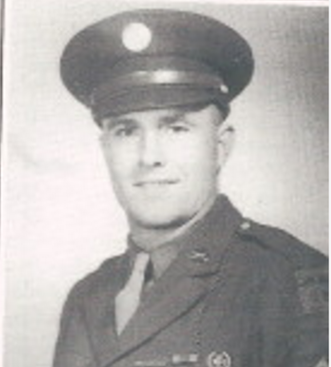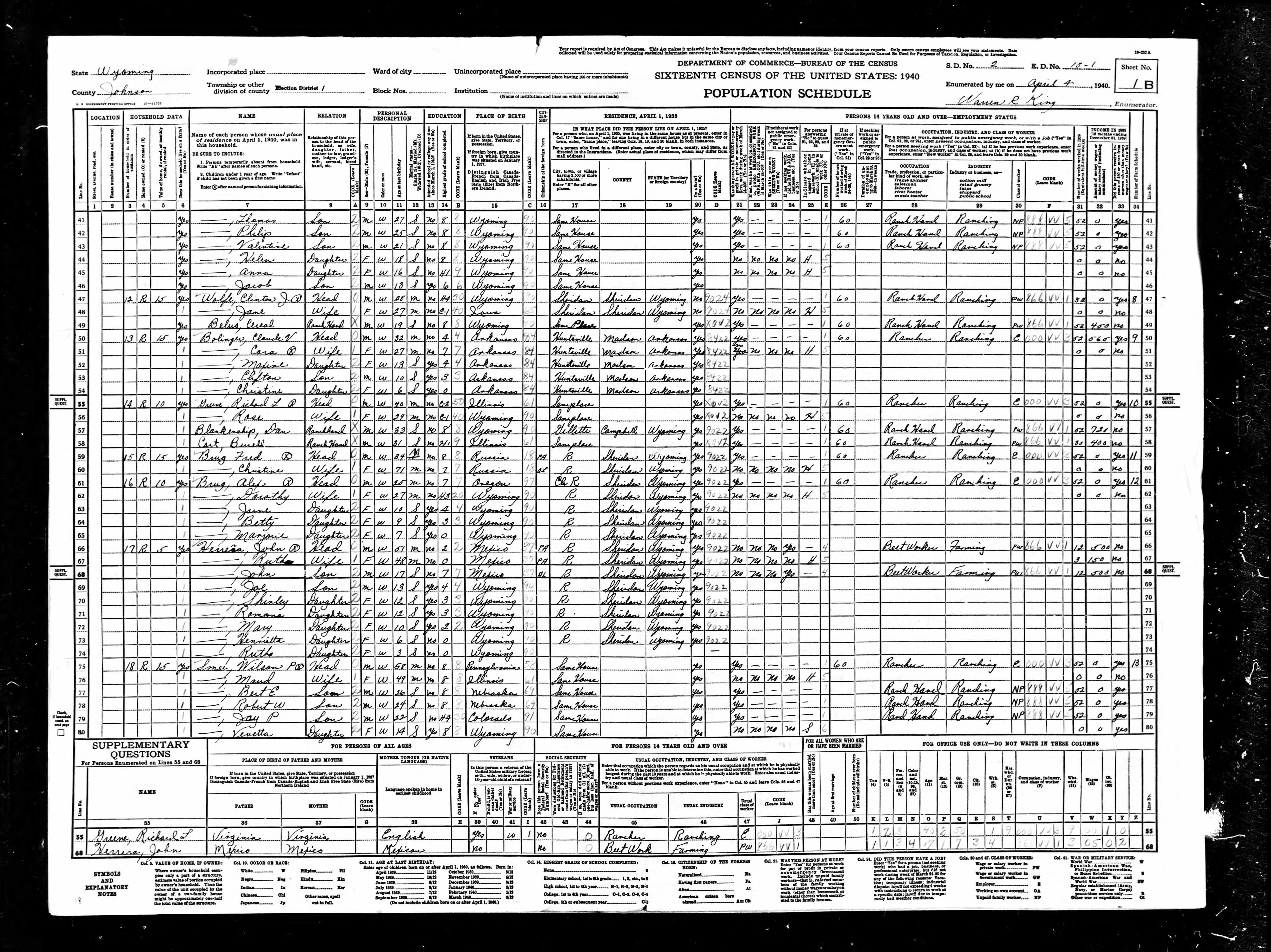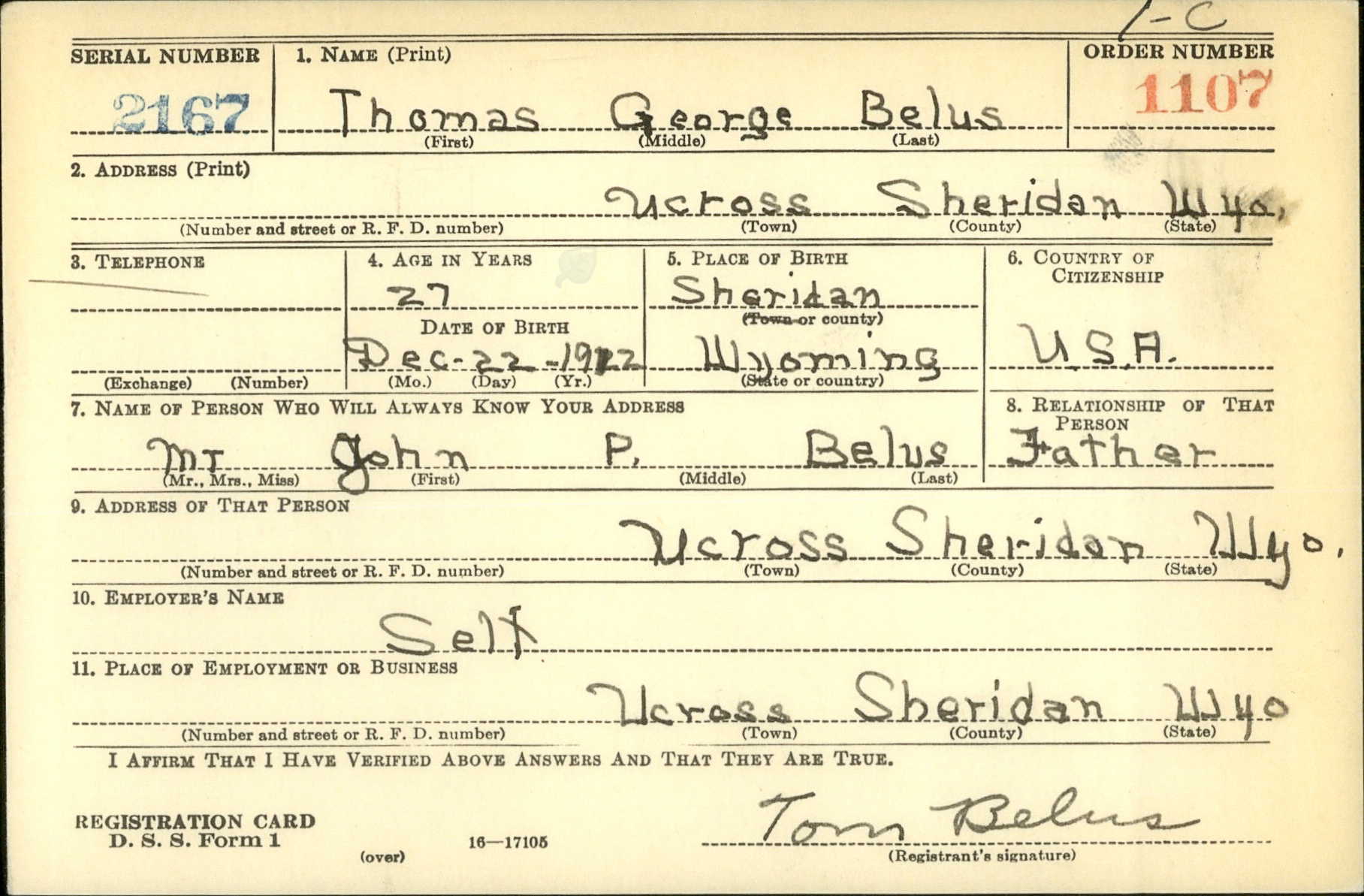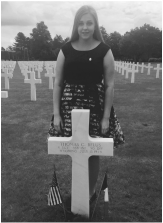Staff Sergeant Thomas George Belus

- Unit: 90th Infantry Division, 358th Infantry Regiment
- Service Number: 37156045
- Date of Birth: December 20, 1912
- Date of Death: July 13, 1944
- Hometown: Sheridan, Wyoming
- Place of Death: near Pont-l'Abbé, France
- Award(s): Purple Heart
- Cemetery: lot C, Row 26, Grave 45. Normandy American Cemetery, Colleville-sur-Mer, France
Lander Valley High School
2015-2016
Early Life
Thomas Belus was born on December 22, 1912. The Belus family were homesteaders who farmed a plot of land just outside of Sheridan, Wyoming. The family attended St. John the Baptist Catholic Church in Buffalo, Wyoming.
Thomas G. Belus was one of five brothers who served in the military, but he came from a family of 15. The 1940 U.S. Census reveals the size of his large family, with seven other siblings ranging in age from 13 to 30, and lists his occupation as a ranch hand.



Homefront
Railroads
The Chicago, Burlington & Quincy Railroad (also known as the Burlington Route or CB&Q), Wyoming’s second transcontinental railroad, completed just before Thomas Belus’ birth, was instrumental for years to come. During the Second World War, according to the Wyoming State Historical Society, “troop transport brought a flood of military-related travel, and CB&Q traffic increased dramatically. The Burlington salvaged 30,000 tons of steel for the war effort by consolidating 87 miles of its line west of Casper with the Chicago and Northwestern.”
Dude Ranching
The Eastern Dude Ranchers Association (1943) was created to promote tourism to Wyoming. Ranching was key to Wyoming as a source of revenue but was equally crucial to war efforts in providing food products.

Military Experience
Thomas Belus enlisted in the U.S. Army. He began training at Camp Barkeley, Texas, in 1942. He received an award for his expert bayonet skills. These skills would later carry Belus throughout his two years and seven months in war.
On June 6, 1944, Staff Sergeant Thomas G. Belus landed on Utah Beach and the 358th Infantry Regiment. The majority of the 90th Infantry Division arrived the following day. From here, Belus had the same goal as the rest of the division, to survive, and go deep inland, and secure the southern flank of Cherbourg. Their bloodiest battles came in the hedgerows, heavily fortified lines of defense laid by the Germans, the strongest of which was in Normandy itself. For the next month and five days, Belus moved throughout the Cotentin peninsula toward the town of La Haye-du-Puits.
After fighting in hand-to-hand combat throughout France, Belus’s battalion executed a courageous flanking maneuver two days before his death near Pont-l’Abbé. This maneuver resulted in significant casualties but allowed American forces to cross the Mahlman line. Shortly after crossing this line, Belus was shot in the abdomen. Staff Sergeant Thomas Belus died at age 31, on July 13, 1944.


Eulogy
On June 6, 1944, Brigadier General Theodore Roosevelt Jr. led the first wave of American forces on Utah Beach starting at 6:30 a.m. Earlier, a majority of the 13,000 paratroopers missed their targets. Despite the confusion, their objectives were seized, and ultimately over 600 Airborne troops died. With great sacrifice and strategy, forces were ultimately successful in isolating the seaborne invasion force from German units. At the end of D-Day, the landing on Utah Beach was considered a success because of the sacrifice and dedication that the Allied troops gave to overcome the obstacles they faced at Utah Beach.
On June 6, 1944, the 4th Infantry Division landed on Utah Beach. The first men landed around two kilometers away from their target. Despite this mistake, Brigadier General Theodore Roosevelt Jr. famously quoted that “We’ll start the war from here!” This allowed the men to move forward from here despite the great confusion among the beach as paratroopers missed their drop zones and were scattered throughout the Cotentin peninsula. The goal of the landing was to cross the beach and seize control of the coastal roads, meet up with airborne troops and prepare to attack Cherbourg. However, throughout the landing, the beach attack presented several obstacles that made this very difficult. Due to this, Utah Beach forces were not able to gain all planned objectives. Still, it is with great luck and fewer German defenses compared to Omaha Beach that allowed this attack to be considered a success ultimately.
Thomas Belus landed on Utah Beach, in the afternoon, on June 6. Although it took two days for the 90th Infantry Division to gather near the beach area, the division was instrumental in its success on Utah Beach and the capture of Cherbourg.
Staff Sergeant Thomas George Belus, a patriot, brother, son, and hero, lost his life on July 13, 1944. Belus was a man who worked 52 weeks a year to help provide for his family of 15. He was a man who received only an eighth-grade education yet knew the actual value of sacrifice. These core values shaped Staff Sergeant Belus and compelled him to enlist in the military alongside five of his brothers.
Staff Sergeant Belus served in the U.S. Army for two years and seven months, but in his final days, he fought as a part of the 90th Infantry Division, 358th Infantry Regiment for just over a month. After arriving on D-Day, his regiment moved throughout Normandy with rain pouring and casualties surrounding his every move. When the 358th Infantry Regiment moved from Utah Beach inland towards La Haye-du-Puits, great efforts were made to persevere and move onward. We must therefore remember Staff Sergeant Belus for these courageous sacrifices and honor his death.
Of his brothers, Staff Sergeant Belus was the only one that did not return home. With a heavy heart, we honor him today for the sacrifices that he made and remember his life for the Belus family that never got to see him again. We know today that he is with the Lord in Heaven, and I imagine he is among his family, looking down among those serving today in hopes that they will return safely to their families, as he never did.


Reflection
When I found out that I had earned a spot in the 2016 Normandy: Sacrifice for Freedom Student and Teacher Institute, I would never have thought in a million years that it would impact me that it has. My mom grew up in a military family, so I have always appreciated men giving their lives for something greater. I understood that being in the United States military meant leaving and being away from home to fight for freedom and their love of their country. However, the real meaning of sacrifice has only begun to resonate with me because of this Institute. I spent countless hours learning and researching World War II, the D-Day invasion, Thomas Belus, strategies, operations, attacks, and impacts to understand better war and the value of the lives taken. On the day that I walked on Omaha Beach, I felt as though everything had come full circle, and the emotion that overtook me is one that I will never forget. On that day at Omaha Beach, I understood how important it is to experience something like this for oneself. You can research and learn so much, but seeing the beaches that the men sacrificed their lives on is an experience unlike any other.
Besides learning so much and honoring fallen soldiers most memorably, the encounters I had in France with locals and friends I made are ones that I will never forget. Having never traveled outside of the country, I am glad that this could be my first memory overseas. The friends that I made at this Institute are ones that I know I will have for life, and the laughs and sights that I enjoyed with them will forever be with me. I am so thankful that I could be a part of this adventure and for the people that I shared it with.
Before the Institute each student who earned their place promises to tell about their experience and share the stories of their fallen soldier, but I found it hard not to say to every person I met. The stories that I learned will always stick with me, and I look forward to telling those stories so that they may live on. Every hero deserves to be remembered for their sacrifices that ensure our freedom today. The lives are not just another number or casualty, but rather every number is a story, a story waiting to be told.
Bibliography
Primary Sources
Bryan, Lieutenant Colonel Charles B. “Battle History, Third Battalion, 358th Infantry.” The 90th Division Association. Accessed July 20, 2016. www.90thdivisionassoc.org/90thDivisionFolders/358thhistorybook/358thhistory.htm.
“Card of Thanks.” Sheridan Press, August 27, 1944.
“Cpl. Thomas G. Belus…” Sheridan Press, April 27, 1943.
“Killed in Action.” Sheridan Press, August 13, 1944.
LUNA Photograph Archive. Wyoming State Archives.
“Only one to make expert rifleman…” Sheridan Press, May 17, 1943.
“Requiem High Mass to Be Held for Sgt. T. G. Belus.” Sheridan Press, December 13, 1944.
Thomas G. Belus. Headstone and Interment Records for U.S. Military Cemeteries on Foreign Soil, 1942-1949. Digital images. ancestry.com.
Thomas G. Belus. Individual Deceased Personnel File. Department of the Army.
“Thomas G. Belus Killed in Action.” Sheridan Press, August 8, 1944.
Thomas George Belus. World War II Draft Cards Young Men, 1940-1947. Digital images. ancestry.com.
Wyoming. Johnson County. 1930 U.S. Federal Census. Digital images. ancestry.com.
Wyoming. Johnson County. 1940 U.S. Federal Census. Digital images. ancestry.com.
Wyoming. Sheridan County. 1920 U.S. Federal Census. Digital images. ancestry.com.
Secondary Sources
“The 90th Infantry Division During World War II.” United States Holocaust Memorial Museum. Accessed August 2016. www.ushmm.org/wlc/en/article.php?ModuleId=10006141.
Collins, Mary Jane and Ky Dixon, Editors. Homesteads, Cowboys, Coal Mines: Lower Piney & Boxelder Creeks, 1876-1976. Sheridan County Library System, 1976. sheridanwyolibrary.org/wp-content/uploads/Homestead-Lower-Piney.pdf.
“History of the 358th Infantry Regiment, 90th Infantry Division.” The 90th Division Association. www.90thdivisionassoc.org/90thDivisionFolders/mervinbooks/358/358mainpage.htm.
“History of St. John the Baptist Catholic Church – circa 1851 to 2000.” St John the Baptist Catholic Church. 2016. Accessed July 27, 2016. sjbc-buffalo.com/about-st-john-the-baptist-histroy.
Nickerson, Gregory. “The Burlington Route: Wyoming’s Second Transcontinental Railroad.” Wyoming State Historical Society. Updated November 8, 2014. Accessed April 18, 2021. www.wyohistory.org/encyclopedia/burlington-route-wyomings-second-transcontinental-railroad.
Peterman, Cynthia. ” Teaching the Holocaust with Primary Sources at the National Archives and U.S. Holocaust Memorial Museum.” National Archives Education Updates Blog. January 25, 2021. education.blogs.archives.gov/2021/01/25/holocaust-primary-sources/.
“Sun Up Ridge, Natrona County, Wyoming.” Some Gave All Blog, January 31, 2021. warmonument.blogspot.com/2012/01/this-unique-memorial-is-sun-up-ridge.html.
“Thomas G. Belus.” American Battle Monuments Commission. Accessed April 17, 2021. www.abmc.gov/decedent-search/belus%3Dthomas.

